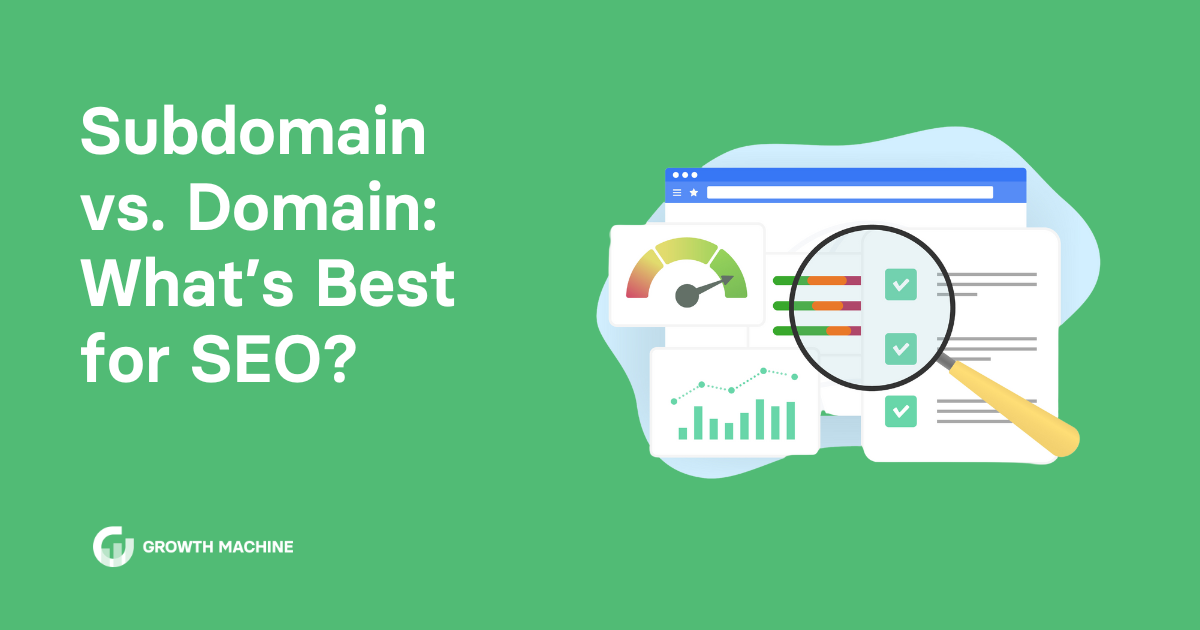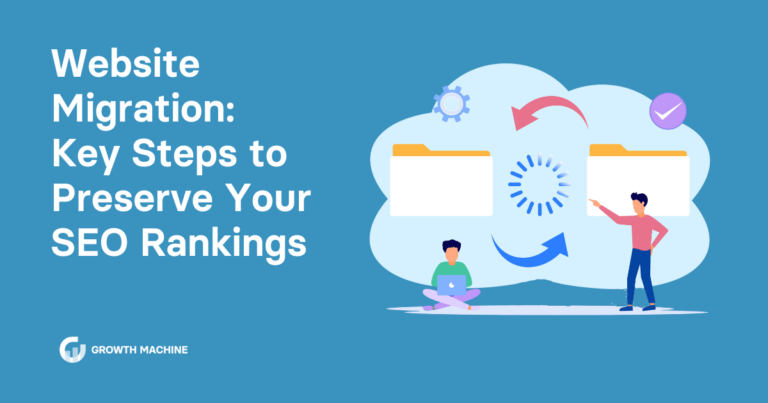Subdomain vs. Domain: What’s Best for SEO?
Search engine optimization (SEO) involves optimizing a lot of factors. From your site’s content to your presence on social media, there are so many things that affect your rankings.
But did you know that your website domain matters, too?
The backend setup of your site has a big impact on how search engines and users navigate the site—and that has a direct impact on your website rankings.
Some SEO pros believe subdomains are the way to go, while others say domains are your best bet. When it comes down to it, the best option depends on your situation.
Let’s look at the differences between subdomains vs. domains and how you can optimize both for a better user experience that boosts organic traffic.
Subdomain vs. Domain: What’s the Difference?
The biggest difference between subdomains vs. domains is the URL structure.
Your domain (which is also called a root domain, main domain, or top-level domain) is the unique address that identifies your website on the internet. For instance, www.example.com is a domain.
A subdomain is a second-level domain that belongs to your primary domain. Businesses usually use subdomains to navigate to different sections of a website. For example, shop.example.com would be a subdomain of the parent domain www.example.com.
The SEO Effects of Using a Subdomain vs. a Main Domain
Both subdomains and domains have a big impact on SEO.
Search engines look at your main site’s age to see how reputable you are. They usually give preference to sites that have been around for a while. Including keywords in your domain name can also help with search engine rankings because it makes it clear what your site is about.
Ranking a subdomain is similar to ranking your main domain. Search engines still care about the subdomain’s age, authority, keywords, and other ranking factors.
But in practice, a subdomain can have a big impact on SEO. Search engines treat subdomains as completely separate websites.
This means the SEO metrics of your main domain and your subdomains are totally separate. So, if you have a high-traffic subdomain with lots of backlinks, it won’t necessarily boost the SEO of your main domain.
Creating a subdomain is akin to creating a totally new website, SEO-wise, so you need to think carefully before creating a new domain.
Is a Subdomain a Separate Domain?
Technically, a subdomain isn’t a separate domain at all. It’s a separate section of your site that has its own URL.
But practically speaking? Yes, search engines view a subdomain as a completely separate entity.
Is It Better to Have a Subdomain or Domain?
There’s no right or wrong answer here. Both domains and subdomains have their pros and cons, so it’s up to you to determine which setup makes the most sense for your website.
It’s best to use a subdomain for:
- Niche targeting: If you have a huge website or lots of products for different audiences, it can be a little overwhelming. Creating subdomains makes it possible to target different users with separate SEO strategies, keywords, and content marketing.
- Localization: Many international companies will create subdomains to target certain geographic areas or users who speak a different language. This is helpful if you want to start ranking in local SEO searches.
- Organization: If you have a gigantic site that’s hard to navigate, it could hurt the user experience and, as a result, your SEO. Using a subdomain makes your site architecture more navigable, which could reduce bounce rates and steadily improve SEO performance over time.
Subdomains definitely have their benefits, but they aren’t right for every business. It’s best to stick with a root domain for:
- Brand consistency: If you want a single, unified brand experience, it’s best to keep everything on a single domain. It’s also best to use one domain if your web content speaks to just one type of user or buyer.
- Domain authority: All of your backlinks go to a single URL with just one main domain. This makes it easier to build domain authority and potentially see SEO results more quickly than a subdomain.
- Simpler SEO: From content creation to strategy, optimizing one site for SEO already requires a lot of work. Splitting domains creates more work for your team, so if you’re trying to do SEO with limited resources, stick with a root domain for now.
Optimizing Main Domains for SEO
Follow these quick tips to boost your main domain’s SEO rankings.
1. Create Content Consistently
Search engines want to send users to sites that regularly create quality content. Posting regularly on your company blog or social media pages will build up your reputation over time, so create new content on a consistent schedule.
If the very thought of that sounds overwhelming, we’ve got your back. Growth Machine can create content for you that follows search engine guidelines, grows your site authority, and boosts conversions.
2. Optimize the Site Backend
Don’t overlook the power of optimizing the backend of your site. This includes optimizing metadata like:
- Web page headers
- Title tags
- Image alt tags
- Meta descriptions
This is easy to do on platforms like WordPress, but if you’re using a custom site setup, ask your webmaster for help.
As always, optimize your site for mobile users, check your site speed, and install an SSL certificate.
3. Use a Simple URL Structure
How easy is it for people to navigate your site? The cleaner and simpler your URL structure, the better. This is better not just for human users, but for search engine crawlers, too.
Revamping your site structure might take a little upfront work (and a lot of 301 redirects), but if it saves you the trouble of creating a subdomain, it’s worth it.
Optimizing Subdomains for SEO
Optimizing a subdomain is trickier because you’re optimizing two separate entities. Follow these tips to set up an SEO-friendly subdomain with less fuss.
1. Create a Unique SEO Strategy
Search engines consider your subdomain as a totally separate website, so you need a unique SEO strategy tailored to this subdomain. That includes:
- Keyword strategies
- Content creation
- Linkbuilding strategies
You should have different goals for your subdomain, so set up Google Analytics and key metrics, too. This is the best way to understand whether your subdomain is helping or hurting your SEO efforts.
2. Boost Your Technical SEO
This is technically a different website, so whatever you do to maintain your root domain, do it for your subdomain, too. That might include virus scanning or regular speed tests.
It’s also a good idea to:
- Use a new IP address: Work with your webmaster or web hosting company to move your subdomain to a separate IP address. This helps with website security and makes things a little bit easier to track on the analytics side.
- Generate a sitemap: Create an XML sitemap for your new site and submit it to search engines. This could speed up how quickly your subdomain ranks in search.
- Interlink subdomains: This helps share link juice as users navigate through the different areas of your website. Over time, search engines will see the relationship between separate subdomains, too.
3. Localize and Customize
A new subdomain gives you the freedom to be very specific and targeted. Instead of keeping things general, be very targeted in your language and offerings.
If you haven’t already, consider creating buyer personas for this subdomain. From there, create content that blends both your keyword strategy with your buyer persona pain points.
4. Keep the Branding Somewhat Consistent
Your subdomain operates separately from the root domain, but that doesn’t mean it should look separate. The last thing you want to do is spook visitors by taking them to a page that looks nothing like your main website.
Keep your subdomain branding elements consistent so users understand that this is still for the same company, just at a separate URL.
Dominate Google Search With the Right Domain Setup
In the showdown between subdomains vs. domains, there’s no clear winner. Ultimately, the best choice comes down to your SEO goals.
Subdomains give you an opportunity to target niche audiences, but they require extra management. Sometimes a well-optimized main domain can be enough to boost your SERP rankings over time.
Ultimately, whether you choose to use subdomains or stick to a single domain, it’s the quality of your content, the user experience, and your understanding of SEO best practices that will drive your website’s success.
You don’t have to do this alone, either. We know you’re busy, which is why Growth Machine’s team of SEO experts is here to help. Growth Machine creates your SEO strategy, manages it for you, and tracks your most important metrics to get you across the finish line, faster.
Ready to get started? Chat with Growth Machine now to see if you should go with a subdomain vs. a domain.







